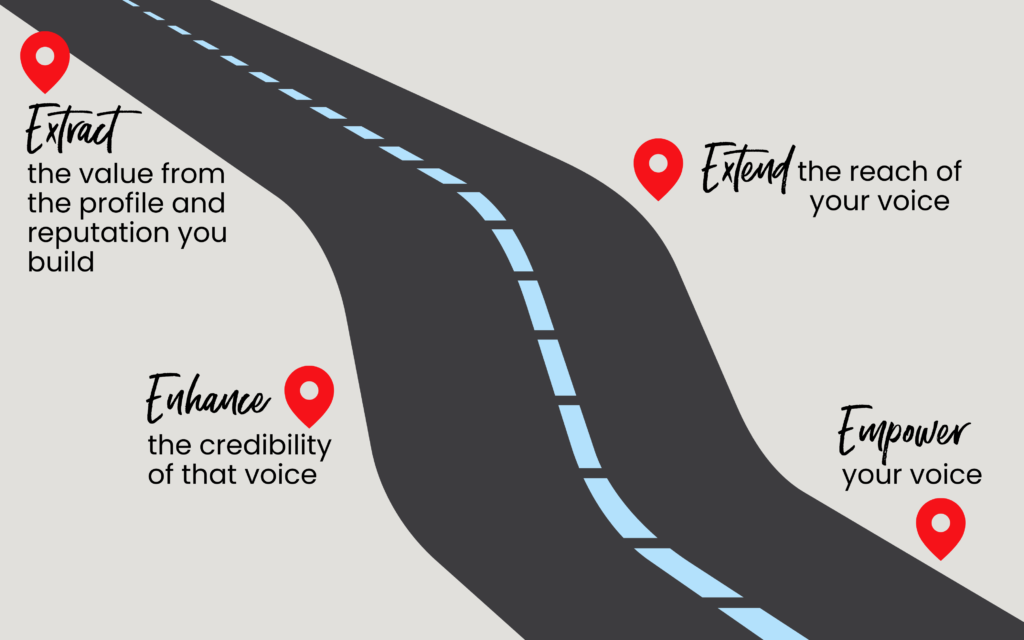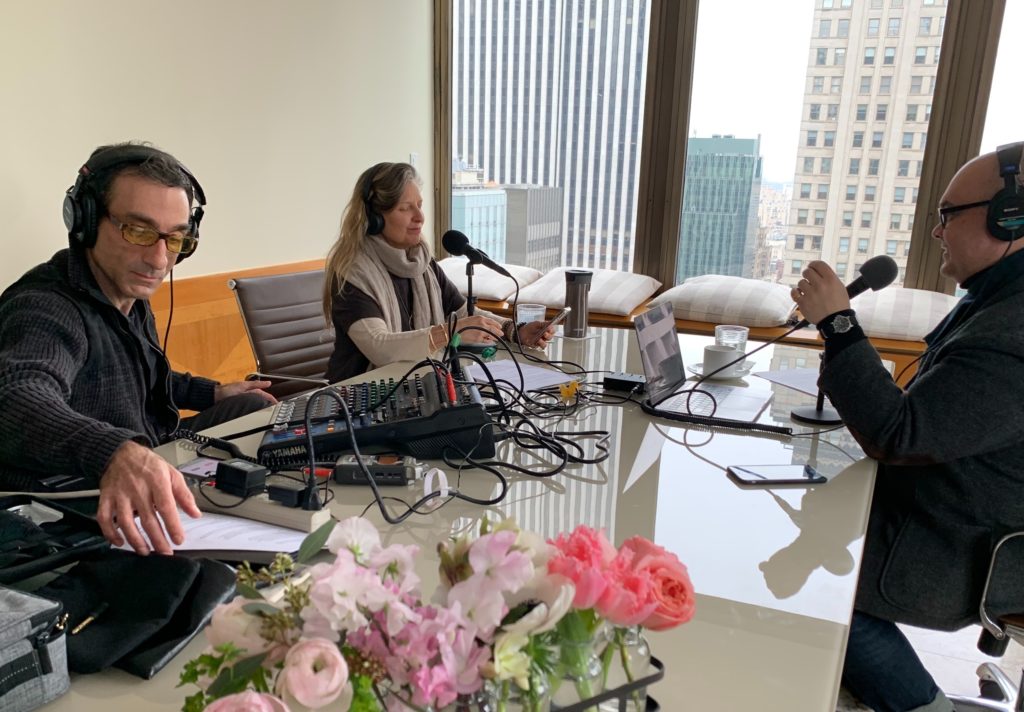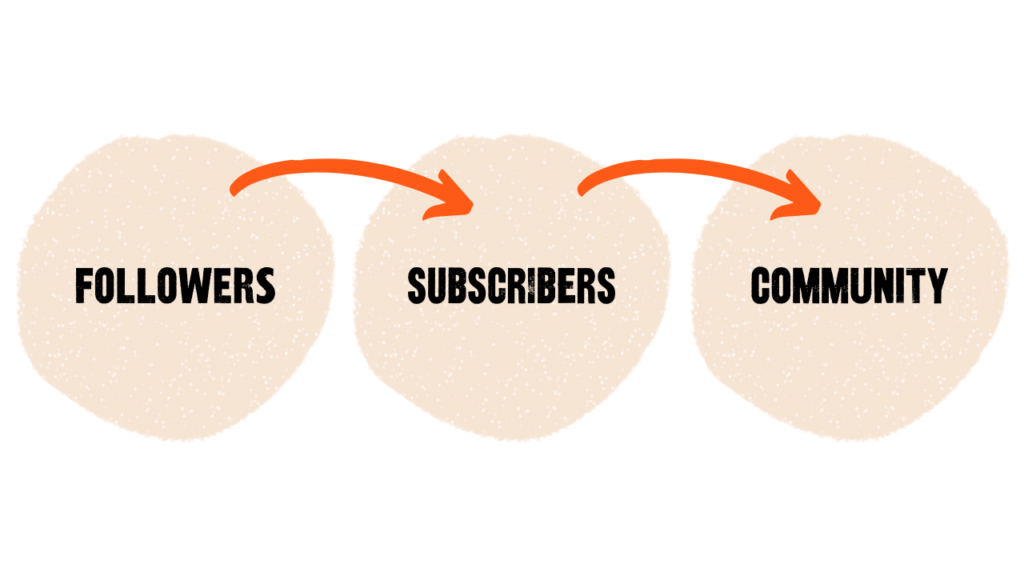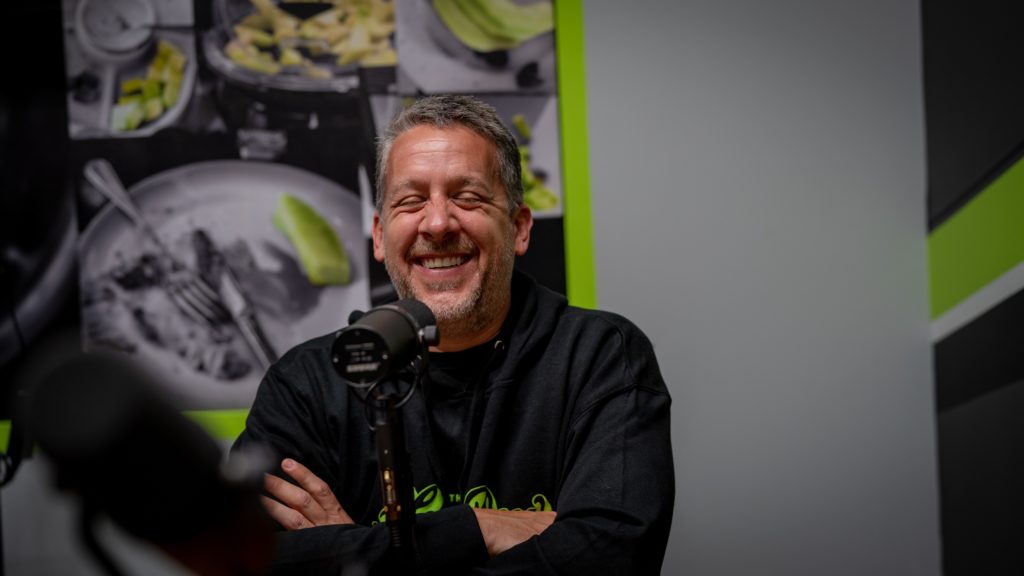
There’s a whole lot more to building and leveraging a professional personal brand today than just having a solid profile on LinkedIn (as important as that is).
But first … why do I call it professional personal brand?
It’s my way of differentiating the way I approach personal branding i.e. working with people of substance who have credibility and the runs on the board; they don’t want to be famous for the sake of it, but they realise that having a strong profile and reputation is good for business (and their career, if that’s the path they’re on).
In this article, I lay out my ‘4Es’ framework for building a credible personal brand in a way that’s strategic, sustainable and respectful, with the goal of helping you grow visibility and influence so you can create more impact in the marketplace.
I call it the Credible Authority Method. (I’m thinking about turning this concept into my next book).
There are four pillars to the framework. They are:
- EMPOWER your voice
- ENHANCE the credibility of that voice
- EXTEND the reach of your voice (your story and message)
- EXTRACT the value from the profile and reputation you build
Let’s unpack each stage separately:

1. EMPOWER your voice 🔥
This pillar focuses on STRATEGY and MINDSET.
Strategy is critical, as we all know. If you haven’t got a sense of purpose or direction that comes with thinking through your strategy and what it is you are wanting to achieve, then it’s really easy to veer off-track. It’s hard enough to cut through at the best of times with our story and our message without sabotaging our efforts through lack of purpose.
I know ‘strategy’ is an overused word, but simply, it’s your plan: Where are you now, where do you want to be, and how are you going to get there? Importantly, it doesn’t need to be overcooked.
There are a few things that are important to cover, such as:
- Having a good understanding as to what makes you unique.
- What are your professional points of differentiation?
- What are your goals and aspirations?
- How do you want to be positioned in the marketplace?
- What does your narrative (story/message) look and sound like?
This is but the starting point. Strategic considerations pop up as we work through the Credible Authority Method (i.e. the ‘4Es’).
Equally important is mindset.
If you want to get serious about growing your professional personal brand but are not in the right headspace to do so, you run the risk of going around in circles.
Mindset to me is a catch-all for a few things that basically fall within two ‘buckets’ – (a) embracing the opportunities, and (b) overcoming internal roadblocks.
Embracing the opportunities:
- A willingness to learn and adapt to technological change
- A willingness to ‘put yourself out there’ on the social web and share your story and your ideas
- A willingness to be genuine and authentic in your content and communication with others
Overcoming internal roadblocks (aka self-sabotage):
- Imposter syndrome
- Lack of confidence/feelings of inadequacy
- Pursuit of perfectionism
If we can’t get our attitude and mindset right and get on top of roadblocks and issues caused by self-sabotage, then we can never effectively put ourselves out there in the online world to build a personal brand that is truly representative of our professional selves.
👉 How can we create powerful, thought-provoking content if we’re constantly second-guessing ourselves?
👉 How can we provide useful tips and ideas on social channels if we don’t deem ourselves worthy enough to do so?
I think ‘embracing the opportunities’ element is probably the easy part. Yes, it involves change, but it’s not as if this change has been thrust upon us in recent times: blogging has been around since the late nineties; podcasting began to catch hold in late 2004; YouTube was launched in 2005, while LinkedIn is coming up to 20 years.
It’s attitudinal more than anything, and it gets easier the deeper you throw yourself into the ‘online personal branding space’, for want of a better description.
The internal roadblocks, however, can take a while to overcome.
With some people, this self-doubt and second-guessing can be crippling. I’ve been there: I’ve had to battle imposter syndrome over the years, even when I had way more runs on the board than many in my industry.

How did I overcome it?Just by ‘shipping it’, as Seth Godin would say.
And the more I shipped, the easier it got. Sure, I had my moments where I deemed myself not worthy enough to be putting content out on the web, but word by word, video by video, interview by interview … my confidence grew.
Ditto with public speaking. I was a nervous wreck at the thought of standing on a stage and speaking to an audience. Why would anyone want to listen to me? But things got easier with each presentation to the point where I now embrace the challenge of delivering a presentation (you can read about my speaking journey here).
“The resistance is waiting. Fight it. Ship.” ~ Seth Godin
I know a lot of real pros who are paralysed because they’re afraid to put out work – to publish content – that’s not perfect.
This whole notion of not letting perfect get in the way of getting it done is very real, especially in the content creation game, and it’s something we all need to get very comfortable with.
2. ENHANCE the credibility of your voice 🔥
With a clearer idea what it is we want to achieve and how we want to be positioned – what our ‘reputational flags in the ground’ are – we turn our focus to content and social media.
This is about becoming our own media channel and building an audience of people who like what we do, who resonate with our story and embrace our message and ideas.
There are still some strategy matters to attend to at this point. They become clear as we we start planning our content efforts. For example, we need to:
- identify who makes up our desired target audience group/s
- ascertain their informational needs (plus understand what inspires them)
- map out and prioritise our owned media and social media channels
- confirm the core elements of our owned/social media efforts, including content pillars, signature content offerings etc
- decide how we’re going to roll out our program across owned and social channels: What’s going to be our publishing frequency? Which tools do we need to get the job done? Do we need a copy/video/audio editor to sharpen up our articles/videos/podcasts? Do we need to engage a virtual assistant to help with content repurposing and social media scheduling?
- determine which metrics we’re going to monitor and measure: what does success look like?

The other part of the ‘enhance the credibility of your voice’ is all based on taking action i.e. the development, production and delivery of your written, video and audio content, distributed via your owned media and social channels. #BOOM!
Alrighty. Get the foundations right here, and then we can move on to …
3. EXTEND the reach of your voice 🔥
With the mindset and strategy boxes ticked, content and social media humming along, it’s time to start focusing on growing our audience, while concurrently deepening the level of connection we have with genuine fans of our work: those allies, champions and enthusiasts of who you are and what you’re all about.
This phase is about building your ‘digital neighbourhood’ and growing your sphere of influence in a respectful way.
Strategically, there are two parts, and both require effort on your part:
(a) a conscious effort to spread your message and ideas further than your immediate networks and audience, and …
(b) engaging with members of your audience with a view to building relationships, cultivating advocacy and generating positive word-of-mouth buzz.
Let’s look at (b) first, ‘cos it’s important 😁
I constantly see people who are busy building their thought leader brand and are doing a good job, but they focus way too much on growing their audience at the expense of engagement. This is fine, I get it: we all want sizeable audiences, even though it’s largely an ego-driven exercise. But it’s also short-sighted.
Personally, I reckon it’s better to have less followers and subscribers (who engage with you, your content and your message) versus having heaps and heaps of people follow you (but who don’t really give a shit).

By all means, grow your audience, but also set aside time to engage with people.
Deepening the connection you have with your followers is all about building something of substance for the long term: a sustainable personal brand along with a community of like-minds who are invested in you and your ideas.
This means:
- getting into the social trenches with people on an individual basis
- proactively reaching out to your ardent followers to say “hello”, to recognise and acknowledge them, to comment on their social posts, to share their content
- encouraging your email subscribers to write back to you so you can discover more about them, and what their challenges, issues and aspirations are
- attending events where members of your audience are likely to be, and mixing with them.
As writer David Perell recently tweeted: You can buy reach, but you can’t buy trust.
Building a community of fans, followers and advocates is all about establishing and nurturing bonds of trust, not just with you and your brand, but also, over time, with each other. A community is not just about the figurehead, as important as they are, but the interaction and genuine connection between its members.
“Activate your fans. Do not just collect them like baseball cards.” ~ Jay Baer
Okay, now let’s look at (a), which is all about spreading your message and ideas far and wide, beyond your immediate network of friends, peers and existing social media followers.
Think of this section as earned media.
This has traditionally been the domain of PR practitioners, although truth be told, PR pros do a heck of a lot more these days than generating editorial coverage for clients.

In short, it’s about building your audience through media and influencer relations, public speaking, and strategic networking.
Questions to ask yourself:
- Which third-party media outlets reach your audience?
- Which industry conferences and events do people in your audience attend? (Or take notice of)
- Who are the influencers in your space (those with a media platform: content creators OR micro-power brokers who are in a position to influence by dent of their position i.e. head on an industry association, senior executive at a large and respected company, an author who might not necessarily have much of an owned media/social presence)
There’s quite a bit of overlap between media outlets and influencers. At the end of the day, we’re talking about people who have a media platform at their disposal and an audience hungry for fresh content.
I like to separate them out in four ways:
- TRADITIONAL MEDIA – newspapers, magazines (online and hard copy), radio programs (public, commercial and community)
- HYBRID MEDIA – these are digital-only publications with journalistic integrity, often servicing a specific niche; essentially they’re commercial publications: they’re run like a traditional magazine, often by professional journalists, everything from TechCrunch and Lifehacker at the top end, to Mumbrella, Renew Economy and Social Media Examiner at a more vertical-focused level. Today, of course, they’re adding multiple mediums into the mix, for example, videos and podcasts. More recently, we’ve also seen the rise and rise of digital news networks such as Ticker and Ausbiz. Tortoise Media is an interesting multimedia concept: “We’re building a different type of newsroom, for a slower, wiser news”.
- BRANDED CHANNELS – these are media platforms (blogs, podcasts, video shows) created by companies and organisations as part of their content marketing efforts. Some examples include American Express Business Class, Nieman Lab, The Aquent Blog, Spin Sucks, and UnStuck, a podcast by Gumroad.
- INDEPENDENT CONTENT CREATORS – these are one or two person shows who have developed and built their own media channel, whether it be a blog, podcast, email newsletter, YouTube show, or combination thereof. Classic examples: Kate Toon’s The Recipe For SEO Success Show (podcast), Geekout with Matt Navarra, and Paul Sutton’s Digital Download.
All four of the above media categories provide entrepreneurs, professional experts and emerging thought leaders with plenty of opportunities to reach new audiences and broaden the reach of their story and their message.
Public speaking also falls into the earned media bucket.
If you can score a gig speaking at an industry seminar/webinar, a major conference event, a professional association education night, or a simple small-scale community meet-up: these are also good opportunities to grow and connect with your audience.

And finally, at a high-touch, micro-level, strategic networking plays a role too.
Being seen at the right events, whether you’re speaking or not, can really pay dividends if you’re always meeting new people, deepening that connection via LinkedIn, and using your social channels, particularly Twitter, to ‘report from the ground’.
Lots of opportunities here. HEAPS!
4. EXTRACT value from the profile and reputation you build 🔥
Of course, for most people, there’s an end game to this. There has to be. Whether it’s career, or more likely, development of business and partnership opportunities.
At the very least, if you’re an entrepreneur, a leader of an existing business or a professional consultant, there will be commercial advantages to having a high profile and becoming an influential voice in your industry.
But more and more these days, we’re seeing credible professional people chucking in their corporate gig to build up a portfolio of revenue-generating opportunities, including:
- ebooks and digital courses
- membership communities
- group coaching programs
- partnerships and collaborations
- online summits and paid-for webinars
- live events and workshops
- paid public speaking
- coaching and mentoring
- teaching and lecturing
… and of course, the mainstay of consulting and advisory work.
Mark Schaefer is a classic example of a thought leader who has over time built a portfolio career (business) with multiple income streams – 20 of them in fact, read what they are here.
So as you can see folks, lots of opportunities for people who become seen as a credible authority in their field and who, over time, build a professional personal brand that’s liked, trusted and front of mind with a growing audience of fans and advocates.

Thank you for reading … let’s connect on the socials (links below)!
Onwards!
Trevor 💪



Leave a Reply